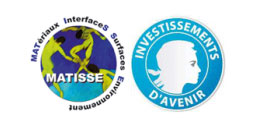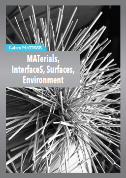Current Controlled Negative Differential Resistance in Niobium Dioxidea

Axe 4 - Dimensionnalité et confinement
Thèse d'Ali Fakih
AAP 2016 - Travail de recherche commencé le 1er novembre 2016
Soutenance de thèse le 5 novembre 2019 à 14h
Salle de conférence 401 - Couloir 22-23 - Campus Pierre et marie Curie
Laboratoires co-porteurs
- Institut de Minéralogie, de Physique des Matériaux et de Cosmochimie (IMPMC)
Porteur de projet : Johan Biscaras
Co-porteur : Abhay Schukla - Laboratoire de Physique et d'Etude des matériaux (Lpem - ESPCI)
Co-porteur : Ricardo Lobo - Institut des NanoSciences de Paris (INSP)
Co-porteur : Jacek Goniakowski
Abstract
Niobium dioxide NbO2 has been recently gaining a lot of interest in the fields of solid-state physics and technological nano-devices. On one hand, NbO2 undergoes a structural distortion accompanied by an electronic phase transition where the material changes from an insulating state at room temperature into a metallic state at temperatures above ∼ 1080 K. On the other hand, NbO2 exhibits a negative differential resistance phase under the application of electric current, a phenomenon known as current-controlled negative differential resistance CC-NDR. These two characteristics in NbO2 promote it to be good candidate to develop many functional devices used for variety of applications such as electric switching and memory devices. However, despite the potentialities of NbO2, the understanding of this material is still incomplete as literature reporting many research work on NbO2 show contradictory or inconsistent information. One possible reason of this lack of consistency could emerge from the difficulty in the film fabrication of pure phase NbO2 and the different means in synthesizing them.
In this thesis, we have fabricated thin films of NbO2 by RF-mangentron sputtering technique on amorphous and crystalline substrates (glass and Si). The deposited films were always amorphous, and annealing treatment of the as-deposited films was necessary to achieve crystallinity. Annealing tests revealed that increasing both the annealing duration and the annealing temperature gives rise to better crystalline films. Optimized amorphous NbO2 films had a resistivity ρamo ∼ 5 Ω.cm while the crystalline films had a ρcry ∼ 50 Ω.cm both which are less than the bulk crystalline NbO2 ρbulk ∼ 104 Ω.cm. Upon performing electronic studies on NbO2, we witnessed CC-NDR with a hysteresis in the V(I) curves. We showed that hysteresis in CC-NDR is due to temperature inhomogeneity. Simultaneous electronic transport and Raman measurements show that CC-NDR is not associated to a phase transition (the phase is always insulating). Moreover, we showed that there is a similar temperature driven change in conductivity in both the amorphous and the crystalline samples, however, the amorphous sample is a better electronic and thermal conductor. Finally, we proved that the CC-NDR may be simply explained by the creation of carriers by temperature in a semiconductor, without the need for invoking more complicated transport mechanisms.
Conférences et séminaires
- GDR MEETICC - Ecole du GDR Matériaux, Etats ElecTroniques, Interactions et Couplages non-Conventionnels
4-10 février 2018, Banyuls sur mer, France
Egalement dans la rubrique
- Thèse de Jonathan Baptista
- Thèse de Florian Beaugnon
- Thèse d'Emmanuelle de Clermont Gallerande
- Thèse d'Elise Duquesne
- Thèse de Cyrine Ernandes
- Thèse d'Amaury Fau
- Thèse de Camille Lagoin
- Thèse de Miléna Lama
- Thèse de Danilo Longo
- Thèse de Lorela Masci
- Thèse de Bertille Martinez
- Thèse d'Elise Médina
- Thèse d'Elisa Meriggio
- Thèse d'Estelle Palierse
- Thèse de Karol Rakotozandriny
- Thèse de Sofiane Schaack
- Thèse de Lionel Tinat
- Thèse de Hancheng Yang
- Thèse de Dan Zhao
MATISSE en chiffres
- 4 disciplines : Chimie, Physique, Sciences de la Terre, Patrimoine
- 400 permanents
Contact
Direction
Florence Babonneau
Administration
Communication
Emmanuel Sautjeau



